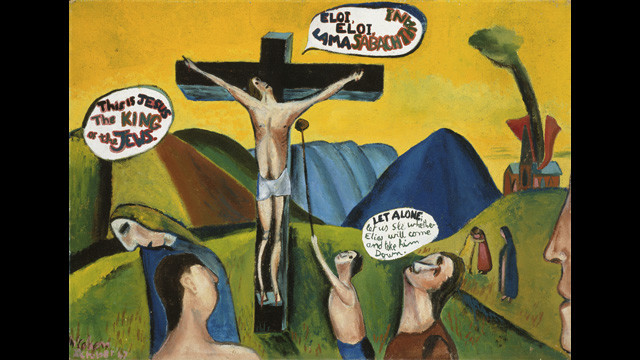Colin McCahon
Aotearoa New Zealand, b.1919, d.1987
Crucifixion according to St Mark
- 1947
- Oil on canvas on board
- Presented by Colin McCahon on the death of Ron O'Reilly, 1982
- Reproduced courtesy of Colin McCahon Research and Publication Trust
- 828 x 1125mm
- 82/50
Tags: buildings (structures), Christianity, churches (buildings), crosses (visual works), landscapes (representations), natural landscapes, people (agents), religious art, religious buildings, stylization, words
Colin McCahon’s interpretation of the execution of Jesus Christ on the cross borrows as much from a vernacular New Zealand setting and European Renaissance art as it does from the Bible’s high-tempo Gospel of Mark. McCahon’s plasticine-coloured hills and sky sing with primary school vibrancy. In the background, Jerusalem’s Temple curtain – which tore in two at the moment of Jesus’ death – is flung high from a simple country church. The speech balloons of Christ and those mocking him below, meanwhile, gain their sense of immediacy from the visual language of comic strips and small-town grocery store signage and packaging.
(As Time Unfolds, 5 December 2020 – 7 March 2021)
Exhibition History
Colin McCahon painted Crucifixion according to St Mark while living at Tahunanui in Nelson. At this time he was studying the work of both old and modern masters, and testing himself against artists from Michelangelo and Titian to Cézanne, Picasso and Mondrian. This painting owes a particular, acknowledged debt to Titian, and was later described by McCahon as being the successful culmination of a group of works dealing with similar themes. The poet James K. Baxter wrote to McCahon in 1947, having been moved by this painting, and commended him for having ‘put onto canvas something I know about [New Zealand], but have not learned to say’. (Brought to light, November 2009)
In this work Colin McCahon has moved the crucifixion of Christ into a New Zealand setting and has used it to comment on the effect the grim aftermath of the Second World War had on the attitude of New Zealanders to the Christian Church. This is a key work in McCahon's religious paintings of the 1940s. The speech bubbles show the influence on McCahon of commercial art and contemporary comic book imagery, with its strong clear outlines, flattened forms and clear bright colours.
Now widely regarded as New Zealand's most important 20th century painter, McCahon was born in Timaru and studied art in Dunedin, first exhibiting his work in 1949. He spent time in Christchurch and Nelson but moved to Auckland in 1953, working first at the City Art Gallery, then teaching at the University of Auckland School of Fine Arts. McCahon established a studio at Muriwai in 1968 and in 1970 resigned from teaching to paint full-time. (Opening Gallery hang, 2003)






